Haverstraw (village), New York
| Village of Haverstraw | ||
|---|---|---|
| Village | ||
 | ||
| ||
| Nickname(s): Bricktown, The Village | ||
| Motto: Et Libertas Natale Solum Fumus Patriae Igne Alieno Luculentior | ||
_highlighted.svg.png) Location in Rockland County and the state of New York. | ||
 Village of Haverstraw Location within the state of New York | ||
| Coordinates: 41°11′47″N 73°58′1″W / 41.19639°N 73.96694°WCoordinates: 41°11′47″N 73°58′1″W / 41.19639°N 73.96694°W | ||
| Country | United States | |
| State | New York | |
| County | Rockland | |
| Incorporated | 1854 | |
| Government | ||
| • Mayor | Michael Kohut | |
| Area | ||
| • Total | 5.1 sq mi (13.1 km2) | |
| • Land | 2.0 sq mi (5.2 km2) | |
| • Water | 3.1 sq mi (8.0 km2) | |
| Elevation | 30 ft (9 m) | |
| Population (2013)[1] | ||
| • Total | 12,102 | |
| • Density | 6,051/sq mi (2,336/km2) | |
| Time zone | Eastern (EST) (UTC-5) | |
| • Summer (DST) | EDT (UTC-4) | |
| ZIP code | 10927 | |
| Area code(s) | 845 | |
| FIPS code | 36-32754 | |
| GNIS feature ID | 0952388 | |
| Website | www.voh-ny.com | |
Haverstraw is a village incorporated in 1854 in the town of Haverstraw in Rockland County, New York, United States. It is located north of Congers, southeast of West Haverstraw, east of Garnerville, northeast of New City, and west of the Hudson River at its widest point. According to the 2013 U.S. Census estimate, the population was 12,102, an increase from the 2010 Census population of 11,910.[2]
The village of Haverstraw is home to Rockland Community College – Haverstraw Extension and is part of the North Rockland Central School District. As of 2009 the mayor is Michael Kohut.[3]
Haverstraw is one of the more urban communities in Rockland County, which makes the village an attractive place to live amongst former New York City residents, the artist community, and New Yorkers with Hudson Valley weekend homes. Because of this, the village is currently in a state of transition as gentrification takes hold. Interest in the village is fueled by its rich history and architecture, its vast Hudson River shoreline and natural amenities, its overall walkability and density, and trans-Hudson ferry service to Ossining and the Metro-North Railroad with direct service to Grand Central Terminal.
History
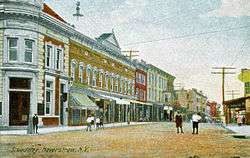
Before Dutch settlers traveled to the Hudson River Valley in the early part of the seventeenth century, the Rumachenanck people, a subset of the Lenape tribe, called the area home. In 1609, during one of the many voyages the Dutch financed in search of the Northwest Passage, Henry Hudson sailed the Hudson River, docking his ship in Haverstraw Bay. It was here that the Dutch declared the Hudson River as property of the Dutch.
Haverstraw was founded in 1666, but the village, known as Florus Falls and also as Waynesburgh, wasn't legally established until March 11, 1854, as the Village of Warren, after Joseph Warren, a Major General who had died at the Battle of Breed's Hill in 1775 during the Revolutionary War.[4][5] Under an act of the state legislature, the name of the village was changed to "Haverstraw" on April 14, 1874, in order to retain its Dutch roots and create a more defined sense of place.
The village is one of the first to appear on maps of North America, listed as Haverstroo, which means "oat straw" as an anglicized version of a Dutch word.
Strategically located on the Hudson River, the village was home to a number of skirmishes between the British Army and the Continental Army during the American Revolutionary War.
Haverstraw was the site of the most grievous treason of the early years of the United States. During the night of September 19 and September 20, 1780, the English emissary, Major John André, was rowed from the sloop-of-war Vulture to a beach below the Long Cove on the southern boundary of Haverstraw. The negotiations to sell the plans to West Point were not completed by dawn, and Benedict Arnold and André traveled to the Belmont House, owned by Thomas Smith and occupied by his brother Joshua Hett Smith, on the grounds of what is now Helen Hayes Hospital in West Haverstraw. The house has since been known as the Treason House.
95th New York Volunteer Infantry
The 95th New York Volunteer Infantry fought in the American Civil War under the command of Ulysses S. Grant, Major General James Samuel Wadsworth and Brigadier General Edmund Rice.[6] Company F was recruited primarily from Haverstraw.[7] The infantry joined in the action of the Railroad Cut on the first day of the Battle of Gettysburg. They fought many battles, including the Battle of Mine Run, Grant's Overland Campaign, the Battle of the Wilderness, Spotsylvania Court House, North Anna, Cold Harbor and the Siege of Petersburg. They saw the war to the end, including engagements in the Battle of the Weldon Railroad, the Battle of Hatcher's Run, and the Appomattox Campaign.
"Brickmaking Capital of the World"
Commonly referred to as "Bricktown", Haverstraw was famous for its brickmaking, which was a major industry for the village. Brickmaking was so popular due to the clay formed by the Hudson River's water and the rich soil that lined Haverstraw's waterfront, that it was nicknamed the "Brickmaking Capital of the World". Many of the old brownstone and brick structures that were constructed in New York City in the late 1890s-early 1900s were composed of bricks manufactured by Haverstraw. At one point, in the early 20th century, there were more than 40 brickmaking factories lining the Hudson River within the village. Although brickmaking involved all the ethnic groups, 60 percent of the brickyard workers were African-Americans.

On the night of January 8, 1906, a landslide demolished a large residential portion of the village. Firefighters responded immediately but faced enormous odds because of burst valves and water mains, gas explosions and hoses which periodically froze because of the cold night. The landslide, a pit about 150 feet (46 m) deep, claimed five Haverstraw streets from Allison to Jefferson roads, 21 buildings and the lives of 4 firefighters and 17 residents. Despite the events, the village rebounded. Eight years later, however, the Cleary-Newman murder took place. The village announced in 2007, the 101st anniversary of the landslide, that a memorial would be erected in honor of the victims of the landslide.
Brick manufacturers 1910
These are the names of suppliers of bricks to New York City metropolitan areas in 1910 with the numbers of machines each manufacturer used, as listed in Within These Gates by Daniel deNoyelles:[8]
|
|
|
|
Recent history

The brick industry continued to thrive until World War II, when brick began to lose its value significantly. Shortly after, the village's main industry of brickmaking declined and left the village. The economic vitality of the village greatly decreased. Because of the amount of vacancies and the relatively inexpensive housing available, the village opened up to Hispanic migration, and the village has become home to many Hispanic immigrant families since the 1950s. Many families of Hispanic descent take part in the village's annual festivals. The Puerto Rican Day Parade and Festival take place in the village's downtown in early June, and the Dominican Day Parade and Festival occur in late August and in September.
In July 1920, New York Yankees outfielder Babe Ruth spent time in Haverstraw to film a movie – Heading Home. A local baseball field bears the Hall of Famer's name due to his visit.
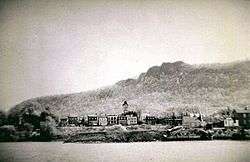
George M. Cohan, the "Father of Modern Broadway", had his debut playing the violin at the Waldron's Opera House on Broadway in the village. The Cohan family stayed in Haverstraw during summer while making their rounds on the vaudeville circuit. The Cohans lived on Division Street, next to a major clay pit in the Village. Cohan was influenced early in his life by the songs of the southern black clay diggers that worked down below the Cohan house in the clay pit. It is often said that Cohan mainstreamed ragtime and jazz through his Broadway tunes.
September 2004 marked the village's 150th anniversary, celebrated by a festival along the village's waterfront. The village has entered a period of revitalization, which coincides with the creation of the Harbors at Haverstraw Community and a sculpture trail which will follow the Hudson River shoreline. The Harbors at Haverstraw is situated on the southern end of the Village and below the higher elevations of the charming riverside southern most neighborhood known as Dutchtown. Some residents have taken to calling the Harbors area the "South End" instead of an older historical term used previously. The State has funded $3 million to the revitalization project, which includes investments on the waterfront esplanade and a possible downtown streetscape project.
As a cost-saving measure, at midnight on January 1, 2006, the Village of Haverstraw Police Department was merged with the Town of Haverstraw Police Department.
Geography

Haverstraw is on the west bank of the Hudson River. Haverstraw Bay is the widest portion of the Hudson River. The bay is bordered by the village of Haverstraw and the village of Croton-on-Hudson in Westchester County to the east.
Haverstraw is located at 41°11′47″N 73°58′0″W / 41.19639°N 73.96667°W (41.196494, −73.96684).[9]
According to the United States Census Bureau, the village has a total area of 5.1 square miles (13.1 km2), of which 2.0 square miles (5.2 km2) is land and 3.1 square miles (8.0 km2), or 60.75%, is water.
Neighborhoods
- The Bank Corner - Downtown Center
- Hahn's Corner - intersection of Westside Avenue and Broadway
- South End - "The Mud Hole," the Harbors Community, and surrounding residential areas
- Dutchtown - Riverside Avenue at northern terminus of the Hook Mountain Nyack Beach Trail
- Uptown - stately, residential district on Hudson Avenue and Hillside Avenue
- Little Italy - Warren Avenue and McKenzie Avenue
- Old Quarter - residential district on Front Street, 1st, 2nd, 3rd, and 4th Street, bounded by Van Houten Street, Canal Street and Broad Street
- Bull Line Blaff - Jefferson Street and Clinton Street
- North Broadway - where Broadway meets Samsondale Avenue
- Silk Mill - between Gurnee Avenue and Spring Street
Demographics
| Historical population | |||
|---|---|---|---|
| Census | Pop. | %± | |
| 1880 | 3,506 | — | |
| 1890 | 5,070 | 44.6% | |
| 1900 | 5,935 | 17.1% | |
| 1910 | 5,669 | −4.5% | |
| 1920 | 5,226 | −7.8% | |
| 1930 | 5,621 | 7.6% | |
| 1940 | 5,909 | 5.1% | |
| 1950 | 5,818 | −1.5% | |
| 1960 | 5,771 | −0.8% | |
| 1970 | 8,198 | 42.1% | |
| 1980 | 8,800 | 7.3% | |
| 1990 | 9,438 | 7.3% | |
| 2000 | 10,117 | 7.2% | |
| 2010 | 11,910 | 17.7% | |
| Est. 2014 | 12,172 | [10] | 2.2% |
As of the census[12] of 2000, there were 10,117 people, 2,816 households, and 2,168 families residing in the village. The population density was 5,078.8 people per square mile (1,962.9/km²). There were 2,925 housing units at an average density of 1,468.4 per square mile (567.5/km²). The racial makeup of the village was 46.02% White, 12.07% Black or African American, 0.37% Native American, 1.09% Asian, 0.13% Pacific Islander, 34.70% from other races, and 5.62% from two or more races. Hispanic or Latino of any race were 59.29% of the population.
There were 2,816 households out of which 43.5% had children under the age of 18 living with them, 47.1% were married couples living together, 23.0% had a female householder with no husband present, and 23.0% were non-families. 17.9% of all households were made up of individuals and 7.4% had someone living alone who was 65 years of age or older. The average household size was 3.42 and the average family size was 3.82.
In the village the population was spread out with 28.6% under the age of 18, 10.9% from 18 to 24, 30.7% from 25 to 44, 18.9% from 45 to 64, and 10.9% who were 65 years of age or older. The median age was 32 years. For every 100 females there were 93.0 males. For every 100 females age 18 and over, there were 89.9 males.
The median income for a household in the village was $42,683, and the median income for a family was $44,881. Males had a median income of $31,503 versus $27,207 for females. The per capita income for the village was $15,442. About 13.9% of families and 16.9% of the population were below the poverty line, including 18.4% of those under age 18 and 23.0% of those age 65 or over.
As of the 2010 census, the population was 11,910, and demographics were as follows:[13]
- Hispanic 67.1%
- White alone: 19.3%
- Black or African American alone: 9.7%
- American Indian and Alaska Native alone: 0.2%
- Asian alone: 2.2%
- Native Hawaiian and Other Pacific Islander alone: 0.0%
- Some Other Race alone: 0.1%
- Two or More Races: 1.4%
Transportation
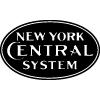
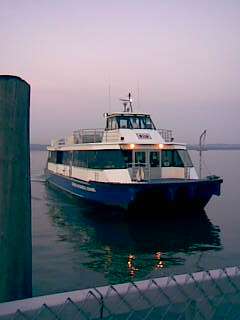
The River Subdivision runs through the village of Haverstraw as a freight-only line, which has an important passing siding located at milepost 35. The River Subdivision is the primary freight rail line between the New York City – Northeastern New Jersey metropolitan area and Albany. Today, the line is operated by CSX Transportation, the fourth railroad to do so. On an average day 20–25 trains pass through Haverstraw. Passenger service along the former West Shore Railroad line stopped in 1959,[14] although the former Haverstraw station building is still standing and currently serves as a law office.[15]
NY Waterway runs a commuter ferry from Haverstraw Village to Ossining, from where there are commuter trains to Grand Central Terminal. A monthly uniticket for the Haverstraw–Ossining Ferry and the train is available from Metro North.
Local transit is operated by Transport of Rockland. The #91, #95, and #97 routes serve Haverstraw.[16][17]
U.S. Route 9W and US 202 run directly through the village.
Haverstraw Fire Department
The Haverstraw Fire Department, a village agency, is composed of five independent, volunteer fire companies that render all facets of fire protection to the village. They are: Rescue Hook and Ladder Co. #1 (on Fairmont Ave.), General Warren Emergency Co. #2 (on Fairmont Ave.), Relief Hose Co. #3 (on Conklin Ave.), Cosgriff Hose Co. #4 (on Maple Ave.), and Lady Warren Hose Co. #5 (on Broadway). In exchange for a body of manpower, the agency provides each company with equipment, quarters, and length of service awards. This department has pull boxes currently used, along with a fire whistle (a Gamewell diaphone) that sounds the pull box number.
Tourism
Historical markers
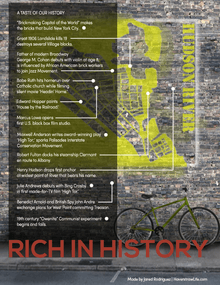
- "Treason Site," Route 9W, where Benedict Arnold met Major John André, a British spy, on September 21, 1780 to exchange plans for West Point - now located at Emeline Park and Main Street.
- "Cohan's Debut," Waldron's Opera House site - Broadway and Lincoln Street
- "Hudson River," Widest Point of River - Front/First Street and Elks Drive
- 1906 "Great Haverstraw Landslide" - Division and Rockland Street
- "Brick Industry" - 183 West Street
- "DeHarte Patent" - 79 North Route 9W[18]
- Haverstraw Historic Site - 25 Fairmount Avenue
- Robert Fulton Clermont Steamship Berth - Emeline Park at Main Street
- Bowline Pond Clay Pit - Broadway at Jefferson Street
- Site of Peck's Dock and small-gauge rail terminal - Utility Pier at Bowline Point Park
- Twin Second Empire Mansions - South end of Clove Avenue
- Site of Babe Ruth home run over St. Peter's Church during filming of 'Headin' Home' Silent Film - Partition Street at Haverstraw Middle School
- Site of the "Franklin Community," an early Communist experimental community influenced by Robert Owen - Spring Street and Rela Avenue
- Site of Franklin Delano Roosevelt address in bid for U.S. Presidency at the United States Hotel - Now U.S. Post Office at Main Street and First Street
- Central Presbyterian Church boasts extinct American Chestnut ceilings and stained glass windows designed by Louis Comfort Tiffany - New Main Street and Hudson Avenue
Landmarks and places of Interest

- Arts Alliance of Haverstraw, 91 Broadway, is a multicultural center for the arts.[19]
- Bricktown Inn, 112 Hudson Avenue, is a Victorian bed and breakfast.
- Central Presbyterian Church, 64 New Main Street at intersection with Hudson Avenue, was founded in 1846 and moved to its present church in 1909, which was built with donated Haverstraw brick and now-scarce American Chestnut wood. The 13 stained-glass windows in the main sanctuary were designed by Louis Comfort Tiffany.
- House depicted in Edward Hopper's painting The House By The Railroad, located along Route 9W just north of New Main Street. The house also inspired the Bates' house set used in Alfred Hitchcock's 1960 movie Psycho.[20][21]
- Haverstraw Brick Museum, 12 Main Street, has exhibits of the over 100-year history of brick-making in the Haverstraw area, once known as "the brick-making capital of the world".
- Haverstraw King's Daughters Village Library, 85 Main Street, is the oldest public library in Rockland County, chartered in 1895. The library opened in Jenkins Hall in 1896 and moved to the National Bank Building the following year. The King's Daughters Society, organized in 1891, was known as the "Haverstraw Ladies Home Mission Circle". Mrs. Everett Fowler, whose husband was president to The Peoples Bank, a state bank, presented a plan to found a public library as a department of the society. In July 1899 the library trustees accepted Denton Fowler's proposition to match the $10,000 for the purchase of the library's present site, which included the provision that the building be named the "Fowler Library Building". The building was constructed with Haverstraw brick from the Fowlers' brickyard. The imprint DF&S can be read on the bricks laid for the basement's floor. During the holiday seasons the library provided baskets for the poor, and throughout the year the library conducted sewing classes for the girls of the village. The library was active in providing relief for the victims of the landslide in 1906. (NRHP)
- The Homestead, Hudson Avenue, is a historic house that is one of the oldest buildings in the village, dating to the early 19th century. In 1983 it was listed on the National Register of Historic Places (NRHP).
- M/V Commander, Haverstraw Marina, is a rare design link between the heavily built-for-steam boats of the late 19th century and the more lightly built vessels of the 20th century. It was listed in 1984 on both the State and National Registers of Historic Places and is also listed in the International Register of Historic Ships, Great American Ships and the Dictionary of American Naval Fighting Ships.[22] It may be chartered for private parties and excursions. (NRHP)
- United States Post Office (Haverstraw, New York), 86 Main Street, is listed on the NRHP.
- St. Peter's Catholic Church, 115 Broadway, was the first Catholic church in Rockland County, where the first Mass was celebrated on November 14, 1847.
- The Congregation of the Sons of Jacob, 37 Clove Avenue, begun in 1877, is the oldest Jewish congregation in Rockland County.
Festivals and events
The following festivals and parades are celebrated in the village of Haverstraw.
- Family Day Festival – celebrated in May
- Haverstraw International Street Fair - Held annually in September.
- Farmers' Market – held every Sunday from May to November 9:00 am until 2:00 pm
- Italian Day Festival – In May Italian Americans celebrate their heritage.
- National Learn to Row Day – Hosted annually on the first Saturday in June by North Rockland Rowing Club at the Haverstraw-Ossining Ferry Landing.
- Annual Brickyard 5000 Regatta – Hosted annually in October at the Haverstraw-Ossining Ferry Landing.
- United Latin Parade – In August 2011, Puerto Ricans, Dominicans, and Ecuadoreans celebrated their heritage as part of the First Annual United Latin Parade. Previously, the Puerto Rican Day Parade and Festival was held in June and the Dominican Republic Day Parade and Festival was held in August.
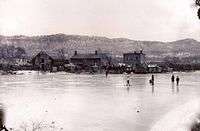
- Puerto Rican Day Parade and Festival – Puerto Rican Americans (Estadounidenses Puertorriqueños) celebrate their heritage. Although announced as the Puerto Rican Day Parade and Festival, the festival is inclusive and embraces all Hispanic-Americans. Many of the participants and spectators attire themselves with hats, bandanas, tees, bracelets depicting Puerto Rico's flag or symbols. Salsa and mariachi bands provide the music, and Puerto Rican cuisine at the food stand included rice (arroz), beans (abichuelas), salad (ensalada), and cuchifritos (“Puerto Rican soul food”) such as Alcapurria, Bacalaítos, morcillas, pernil, and plantains.
- Dominican Republic Day Parade and Festival – Dominican Americans (Estadounidenses Dominicanos) celebrate their heritage. Many of the participants and spectators attire themselves with hats, bandanas, tee-shirts, bracelets depicting Dominican Republic's flag or symbols. Music included merengue and reggaeton, and Dominican cuisine at the food stand included rice (arroz), beans (habichuelas), fried plantain tostones, meat patties (pastelitos), fried foods frituras BBQ pincho kebab, chicharones fried pork, and chimi-churri a tasty hamburger with a Dominican twist.
- Columbus Day Festival – Celebrated in October
Sports
In 2009, Haverstraw was the Girls Little League Baseball Seniors Division state champion, beating the 2008 champion from New Hyde Park by a score of 1–0, leading them to the Eastern regionals in Worcester, Massachusetts.
In 2010, the team were the Girls Little League Baseball Seniors Division state and Eastern regional champions. They defeated national teams from Germany, Puerto Rico and Guam, before losing 3–1 to San Antonio, Southwest regional champions, in the World Series Championship in Roxana, Delaware, on August 14, 2010.
In 2014, Haverstraw was the Boys Junior league Baseball New York State Champions. They went on to play in the Easter Regionals in New Jersey.
Notable people
- Gerard Benderoth, Haverstraw patrolman and World's Strongest Man competitor in 2009. Benderoth, a native of Haverstraw known as "The White Rhino", is a North Rockland High School graduate and former New York City patrolman. He turned professional in 2004 and is currently ranked 10th in the United States.
- George M. Cohan (July 3, 1878 – November 5, 1942), entertainer, playwright, composer, lyricist, actor, singer, dancer and producer. Known as "the man who owned Broadway" in the decade before World War I, he is considered the father of American musical comedy. A full-length dramatic musical entitled George M that depicted his life and which celebrated his music was produced on Broadway in 1968, as did the Academy Award-winning film Yankee Doodle Dandy in 1942. The Cohan family used to live on the easterly end of Division Street.
- Michael A. Donaldson (January 16, 1884 – April 12, 1970), United States Army sergeant and a recipient of the United States military's highest decoration, the Medal of Honor, for his actions in France during World War I.[23]
- Derrick Lassic (b. January 26, 1970 in the village), NFL running back and former husband of Arthel Neville[24]
- Toni Morrison, first African American to be selected for the Nobel Prize in Literature, owns a home in the village. Her novel Beloved won the 1988 Pulitzer Prize for fiction. She has earned the designation of one of the 100 Greatest African Americans of the United States.
- Southcott - pop punk band
Notable people buried in Mount Repose Cemetery
- Peter Denoyelles (1766–1829), U.S. Representative from New York to the 13th United States Congress
- Reuben L. Haskell (October 5, 1878 – October 2, 1971), U.S. Representative from New York from March 4, 1915 until December 31, 1919
- Lotte Lenya (October 18, 1898 – November 27, 1981), Austrian-born, Tony Award-winning and Academy Award-nominated singer and actress
- Kurt Weill (March 2, 1900 – April 3, 1950), German-born, leading composer for the stage and writer of numbers of concert works. Most notable work is the song "Mack the Knife". Married to Lotte Lenya twice – (1926 and 1937).
- Robert A. Widenmann (Jan 24, 1852 – April 13, 1930), [25] National Democratic candidate for U.S. Representative from New York 17th District, 1896. [26] Director of the Haverstraw Light and Fuel Co. [27] Deputy United States Marshal and associate of Billy the Kid during the Lincoln County War [28] [29] [30]
See also
References
- ↑ http://factfinder.census.gov/faces/tableservices/jsf/pages/productview.xhtml?src=CF
- ↑ "Profile of General Population and Housing Characteristics: 2010 Demographic Profile Data (DP-1): Haverstraw village, New York". U.S. Census Bureau, American Factfinder. Retrieved February 2, 2012.
- ↑ "The Village of Haverstraw Mayor's Message". Retrieved 2010-11-05.
- ↑ "Town of Haverstraw: History of Haverstraw: page 5". Retrieved 2010-11-07.
- ↑ de Noyelles, pp. 11–12
- ↑ Ingmire, Lance W. "95th New York Infantry". Retrieved 2010-10-28.
- ↑ 95th Infantry Regiment Civil War
- ↑ deNoyelles, Daniel (1982). Within These Gates (The History of Brickmaking). p. 282. ASIN B0006EAXHA.
- ↑ "US Gazetteer files: 2010, 2000, and 1990". United States Census Bureau. 2011-02-12. Retrieved 2011-04-23.
- ↑ "Annual Estimates of the Resident Population for Incorporated Places: April 1, 2010 to July 1, 2014". Retrieved June 4, 2015.
- ↑ "Census of Population and Housing". Census.gov. Retrieved June 4, 2015.
- ↑ "American FactFinder". United States Census Bureau. Retrieved 2008-01-31.
- ↑ http://www.zip-codes.com/city/ny-haverstraw-2010-census.asp
- ↑ Knecht, James. "Comments On The West Shore from James Knecht". Retrieved 2010-11-04.
- ↑ "New York Collection Law, Collection Practice". Retrieved 2010-11-04.
- ↑ https://rocklandgov.com/files/7913/6181/9564/TOR_RouteMap.pdf
- ↑ https://rocklandgov.com/departments/public-transportation/transport-of-rockland/
- ↑ "De Harte Patent Marker". Retrieved 2010-11-03.
- ↑ "Arts Alliance of Haverstraw". Retrieved 2010-11-04.
- ↑ Wagstaff, Sheena, ed. (2004). Edward Hopper. London: Tate Publishing. p. 234. ISBN 1-85437-533-4.
- ↑ Bochner, Paul (May 1996). "Someplace Like Home: An Eerily Familiar House Rises in Many American Landscapes". The Atlantic Monthly 277 (5): 40–41. Retrieved 24 August 2014.
- ↑ "Commander". United States Navy. Retrieved 2010-11-04.
- ↑ "Medal of Honor citations Archive". World War I War Medal of Honor Recipients. United States Army Center of Military History. June 8, 2009. Retrieved 2009-06-17.
- ↑ Derrick Lassic at the Internet Movie Database
- ↑ http://www.findagrave.com/cgi-bin/fg.cgi?page=gr&GSln=Widenman&GSfn=Robert&GSbyrel=all&GSdyrel=all&GSob=n&GRid=68150117&df=all&
- ↑ http://politicalgraveyard.com/bio/widdis-wiggin.html
- ↑ http://books.google.com/books?id=5vbYAAAAMAAJ&pg=PA508&lpg=PA508&dq=robert+widenmann+haverstraw+new+york&source=bl&ots=SbcnMF8AOE&sig=Xi5qGMZmo28bLfP7dYxKYeUEb0s&hl=en&sa=X&ei=aQU8UsSzLLDi4AO4y4Bo&ved=0CCcQ6AEwAA
- ↑ http://books.google.com/books?id=gABJ88abRooC&pg=PA106&lpg=PA106&ots=2UMphXoBKQ&focus=viewport&dq=robert+bob+widenmann+haverstraw&output=html_text
- ↑ http://www.historynet.com/billy-the-kid-and-the-us-marshals-service.htm/5
- ↑ http://www.mountaintimes.net/Newspaper/41-May2001.pdf
- Town of Haverstraw official website - History section
- Gumucio, Ron X.; January 1, 2006 "Haverstraw village police force disbands". The Journal News
- Incalcaterra, Laura; January 7, 2006 "Remembering the Haverstraw landslides". The Journal News
- Weil, Jennifer; January 27, 2006 "Haverstraw's New Main Street full of history and life". The Journal News
- Terkell, Emily; February 20, 2007 "Brick Museum celebrates black history". The Journal News
- Williams, Margaret (2004) Haverstraw. Avocet Press Inc. ISBN 0-9725078-1-7
External links
| Wikimedia Commons has media related to Haverstraw Village, New York. |
- Village of Haverstraw official website
- Haverstraw Brick Museum
- Hudson River Brickmaking
- Haverstraw King's Daughters Public Library
- HaverstrawLife.com, community forum of local history and current events
- Rockland Magazine
- The Journal News, the local newspaper
- RenewHaverstraw Village, coalition of concerned village residents
- North Rockland Rowing Club, community rowing club operated on the Hudson River
| |||||||||||||||||||||||||




